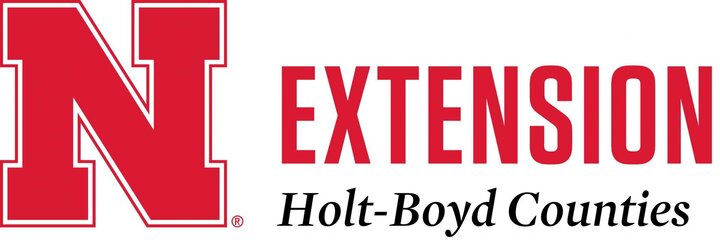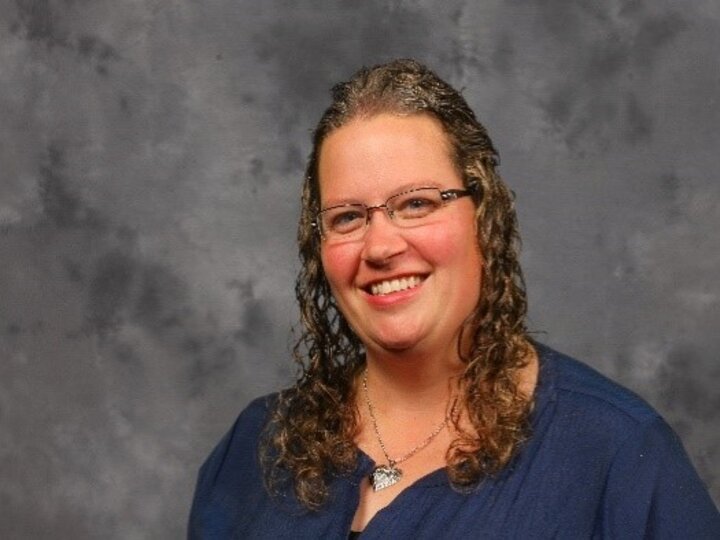
Nebraska Extension Educator - Holt/Boyd Counties - LaDonna Werth
Nebraska Extension Educator - Holt/Boyd Counties - Amy Timmerman
Nebraska Extension Educator - Brown/Rock/Keya Paha Counties - Brittany Spieker
Nebraska Extension Educator - Holt/Boyd/Garfield/Loup/Wheeler Counties - Bethany Johnston
Nebraska 4-H Assistant - Holt/Boyd Counties - Debra Walnofer
December 17: Northeast Nebraska Ag Conference, Norfolk, NE, https://lcnrd.nebraska.gov/
December 30: YQCA Face-to-Face Training, 8:30am-10am, Holt County Courthouse Annex, O’Neill, NE
January 6: DUE: Holt County 4-H Shooting Sports Members Enrollment, https://v2.4honline.com/
January 23: Face-to-Face Private Pesticide Training/Beef Update, 10:30am, Stuart Auditorium, Stuart, NE, pested.unl.edu
January 29: Commercial and Noncommercial Recertification Applicator Training, Holt County Courthouse Annex, O’Neill, NE, pested.unl.edu
February 12: Commercial and Noncommercial Recertification Applicator Training, Holt County Courthouse Annex, O’Neill, NE, pested.unl.edu
The Holiday season is quickly approaching, which means students will be out of school for winter break before we know it! As this time of year brings many happy moments, this can also cause stress among youth and families as this becomes as season of increased expenses, travel, and spending time with loved ones without regular routine. Families can inherit the idea of a “perfect” holiday, which can lead to unrealistic expectations of how one should feel during this time of year. Forty-one percent of Americans stress increase during the holiday season, according to the American Psychological Association.
Some of the most common stressors during the holiday season include an increase in academic pressure as schools are wrapping up the semester, and students become loaded with tests and projects. Families experience a disruption of routine as school is not in session, which can lead to worry about childcare. Finally, family dynamics can become a stressor in ways of hosting holidays, traveling, increased time with family members or the loss family during this time. Some ways to detect these stressors are emotional outbursts, increased irritability, trouble sleeping, increased headaches and stomach aches among youth, and increased defiance.
Strategies to help overcome holiday stressors include:
LaDonna Werth
Extension Educator
Phone: 402-336-2760
E-mail: LWerth2@unl.edu

- Creating a schedule – people, especially youth thrive on schedules. Taking away the school routine for youth can disrupt them, creating a sense of unknown. It is recommended that parents keep their sleep schedule during this time to help mood regulation, immune system support, and improve energy and focus for long hours of holiday activities. Set a plan for the day and week for youth to know what is upcoming for them to feel comfort and control of their environment.
- Act don’t react – When youth are defiant, calmly correct behavior and do not mirror the anger level. Sometimes children want a reaction, so try and react to positive behavior immediately instead of negative.
- Intentional food choices – One of the best things about the holidays are the snacks! Though it may be tempting to just snack all day long, it is important to have balanced meals to help support healthy growth and development, bone strength and immunity.
- Acknowledgement of emotions – there are many factors that cause emotions during this time of year, but expression is important, too. As an adult, check-in with children about their feelings and provide active listening without passing judgement.
- Activities – get your kids moving and out of the house doing something with their hands! Physical activity releases endorphins, to improve mood and promote relaxation which can lead to better sleep. Hands-on activities can provide mindful engagement, incorporating physical movement and creativity!
Information in this article was provided by the Mayo Clinic and Desert Mountain Children’s Center. More information and resources about youth social-emotional development in difficult times can be found at disaster.unl.edu/families. To learn more about this article, contact Mickayla Blender at mblender2@unl.edu.
Source: Mickayla Blender - 4-H Youth Development Extension Educator (UNL For Families – December 16, 2024)
Drones and the Nebraska Pesticide Act
The Nebraska Department of Agriculture (NDA) classifies the use of an unmanned aerial vehicle to apply any pesticide as an aerial application. The Nebraska Pesticide Act (Act) requires all aerial pesticide applicators of any Restricted Use Pesticide (RUP) to possess the Aerial Pest Control category on their applicator license.
Drone Requirements
ALL spray drone pilots must hold an FAA Part 107 certification (or Part 61 manned aircraft license with a UAS endorsement).
ALL drones, regardless of takeoff weight, must be registered with the FAA by the drone owner.
Spray Drone Definitions: “Heavy” UAS or “Heavy” drones (ex. DJI Agras T-50) are drones weighing 55 lbs. or greater on takeoff; Small UAS or small drones (ex. DJI Agras T-10) are drones weighing less than 55 lbs. on takeoff.
For “Heavy” drones, the pilot needs to hold a Class 3 Medical Certificate, which is only granted by an FAA-designated Aviation Medical Examiner. Small UAS weighing less than 55 lbs. on takeoff, no medial certification is required.
For “Heavy” drones, the drone needs to be listed as an approved aircraft for aerial application by the FAA under 49 USC
Amy Timmerman
Extension Educator
Phone: 402-336-2760
E-mail: atimmerman2@unl.edu

Section 44807. Not all “Heavy” spray drones are FAA approved to apply pesticides. “Heavy” drones need to be compliant with this section; only the FAA makes this determination. Small UAS are not required to be approved via Section 44807.
When flying a “Heavy” drone for aerial application, the pilot needs to obtain a Certificate of Authorization (COA) for approval to fly in national airspace. For small UAS, the pilot may only need to request airspace approval through Low Altitude Authorization and Notification Capability (LAANC).
Regardless of takeoff weight, any drone used in aerial application needs to meet the requirements of Part 137 Dispensing Chemicals and Agricultural Products. Since Part 137 is designed for aerial applications with manned aircraft, drone operators need to request various exemptions (also known as Part 137 exemptions) with the FAA to use drones for aerial applications. For small UAS, in addition to Part 137 exemptions, various exemptions to Part 107 need to be requested, such as waiver to transport hazardous materials.
The above FAA regulations apply whether the applicator is applying products to land they own, land they rent, or as a service, and regardless of whether the pesticide is general use or restricted use.
Only pesticides approved for aerial applications may be applied using a drone.
Pesticide Application Requirements
In Nebraska, a person piloting the aircraft or drone is considered the applicator even if they do not handle the product; therefore, the pilot must hold a pesticide applicator license. Mixers and loaders would only need Worker Protection Standard training and would not be required to hold an applicator license.
In Nebraska, NDA requires spray drone pilots to possess either a Commercial or Non-Commercial Pesticide Applicator license when applying Restricted Use Pesticides (RUPs).
Private pesticide applicators making drone applications of RUPs to their personal property or property they rent need to hold the Aerial Pest Control Category 12 by obtaining a commercial or noncommercial pesticide applicator license. (Category 12 cannot be added to private licenses but if a producer is only applying on their property, they can be eligible for a noncommercial with the farm listed as the employer).
Commercial/noncommercial applicators must also pass the General Standards (00) examination. If the commercial pesticide applicator wishes to make pesticide applications to other sites other than agriculture, they must pass the examinations for those categories also.
Once the commercial pesticide applicator obtains all necessary FAA approvals (i.e., Exemptions within Part 107, Part 137, and Section 44807), they will need to obtain a Nebraska Aerial Pesticide Business License.
Additional Resources
Study Manuals for Aerial Pest Control, Category 12 & other categories https://marketplace.unl.edu/pested/commercial-noncommercial-study-materials
PRINT Study Manuals: These hardcopy manuals can be ordered online with a credit card and are mailed to you.
DIGITAL FLIP BOOKS: Our FlipBooks are enhanced digital versions of our traditional print manuals. Most have video training embedded to accommodate multiple learning styles. This is the same video training presented at our initial in-person training sessions. Purchase of a FlipBook gives you a one-year subscription to the product. Internet access is required to use FlipBooks.
Federal Aviation Administration (FAA) Drone Information, https://www.faa.gov/uas
Dispensing Chemicals & Agricultural Products (Part 137) with UAS, https://www.faa.gov/uas/advanced operations/dispensing_chemicals
Nebraska Aerial Pesticide Business License, https://nda.nebraska.gov/pesticide/aerial_license.html
Nebraska Department of Agriculture, Holly Hillebran, (402) 471-6852
https://nda.nebraska.gov/pesticide/applicator_testing.html
Nebraska Extension-Drone Education, Dirk Charlson, (402) 460-0742
Source: Dirk Charlson - Statewide Digital Ag Extension Educator, Gary Stone - Extension Educator, Libby Walsh - Nebraska Department of Agriculture Pesticide/Fertilizer Program Manager (CropWatch – December 5, 2024)
Alfalfa as a Supplemental Protein
Choosing the right protein may help bring the cost of feed down and more accurately meet the needs of our cattle. In some rations, alfalfa might be that choice.
Whether cattle are on winter range, cornstalks, or being fed prairie/grass hay, they often will need extra protein in their diet. Protein sources vary in cost and effectiveness. Protein is important because it is used by the rumen microbes to help break down low quality forage and then used by the animal itself as microbial protein as they pass through the digestive tract. It’s essentially used twice.
Many times, alfalfa is one of the cheapest natural sources of protein. It’s easy to use and doesn’t require additional equipment. Non-protein sources of nitrogen such as urea may be cheap but won’t be as effective with low quality forage as rumen microbes need additional energy to turn the urea nitrogen into protein the animal can use. Alfalfa hay, on the other hand, is highly digestible, feeding both the animal and rumen, often increasing consumption of low-quality feeds.
To be effective, alfalfa should be used as a supplement, not the whole diet, with only enough fed to overcome the deficit in protein the cow has from its current diet. A forage test along with knowing the requirements of the class of animal you are feeding, and consumption rate can be used to determine just how much additional protein will be needed.
Bethany Johnston
Extension Educator
Phone: 402-336-2760
E-mail: bjohnston3@unl.edu

Some winter diets such as winter range, corn stalks, or grass hay may require quite a bit of additional protein supplementation. While supplementing regularly may seem daunting, research has shown supplementing protein three times weekly is just as effective as daily supplementation as long as requirements are being met.
Feeding the right amount and choosing the right protein for your needs can save money. Alfalfa might just be the golden ticket.
Source: Ben Beckman – Beef Extension Educator (CropWatch– December 3, 2024)